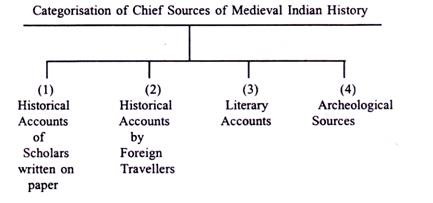Compared to the history of ancient India, a large member of reliable sources are available.
They provide a good deal of insight and knowledge about the conditions of those times-art and architecture, history and literature, agriculture and industry, commerce and trade, culture and civilization, philosophy and religion etc.
In fact available sources cover almost all areas of socio-economic life.
ADVERTISEMENTS:
These sources may be categorized as:
1. Historical Accounts by scholars written on paper:
(i) Tahquiq-Hind (11th cent. A.D.) by Al-Beruni
ADVERTISEMENTS:
(ii) Tarikh-i-Subuktikin (10th cent. A.D.) by Baihaki
(iii) Tarikh-i-Firoze Shahi (13th cent.) by Zia-ud-Barni
(iv)Tuzak-i-Babri (Memoirs of Babur) by Babur
(v) Humayun Nama (16th cent.) by Begum Gul Badan
ADVERTISEMENTS:
(vi) Ain-i-Akbari (16th cent.) by Abul Fazal
(vii) Akbar Nama (16th cent.) by Abul Fazal
(viii) Tuzki-Jahangiri (17th cent.) by Jahangir
(ix) Fatuhali-i-Aurangzeb (17th cent.) by Muhammad Masum
2. Historical Accounts by Foreign Travellers:
(i) Tuhfat-un-Nuzzar fi Gharibi-il-Amsar by Ibn Batuta
(ii) Accounts of Marco Palo (13th cent.)
(iii) Accounts of Nicolo Conti (16th cent.)
(iv) Tarikh-i-Frishta (16th cent.) by Firishta
(Translated by J.Briggs, titled Rise of the Mohammedan Power in India)
3. Literary Accounts:
(i) Shahnama (10th cent.) by Firdausi
(ii) Rajtarangini (11th cent.) by Kalhan
(iii) Prithvi Raj Raso (12th cent.) by Chandbardai
(iv) Padmavat (14th cent.) by Jayasi
4. Archaeological Sources:
A. Medieval Temples:
(i) Khajuraho
(ii) Konark
(iii) Dilwara
B. Medieval Mosques:
(i) Jama Masjid
(ii) Moti Masjid
(iii) Fatehpur Sikri Dargah
C. Medieval Forts:
(i) Agra Fort
(ii) Chittor Fort
(iii) Gwalior Fort
(iv) Red Fort
D. Medieval Palaces:
(i) Jaipur Palace
(ii) Jaisalmer Palace
(iii) Jodhpur Palace
E. Medieval Pillars:
(i) Qutab Minar
(ii) Char Minar
F. Ruins of Medieval Buildings:
(i) Hastinapur
(ii) Firozabad
(iii) Tughlaqabad.
G. Coins of Emperors:
(i) Akbar’s Louis
(ii) Ala-ud-din’s coins
Prominent Historians of Indian history of Medieval Period:
In the 11th century, Alberuni, an Iranian scholar who accompanied Mahmud Ghazni during his invasions of India gave an account of the Indian society in his Tahquiq Hind. Chand Bardai in his epic narrated the exploits of Prithvi Raj Chauhan. Kalhan in that century wrote the history of Kashmir.
In the 13th century, Hasan Nizami, a migrant from Ghazni, gave information about Qutub-ud-din Aibak and Marco Polo provided an account of South India.
In the 14th century, Ibn Batuta, a Moorish traveller wrote about Muhammad Tughlaq, Khwaja Abu Malik described the history of Delhi Sultans, and Zia-ud-Barni covers the history from Balban to Firoz Tughlaq.
In the 15th century Abdul Razzaq described about the times of Vijayanagar kings.
In the 16th century Babur’s Babur Nama, and Abul Fazal’s Ain-i- Akbari and Akbar Nama provided detailed information about these two emperors. In the 17th century, Jahangir himself wrote Tuzki – Jahangiri throwing a lot of light on the period.

